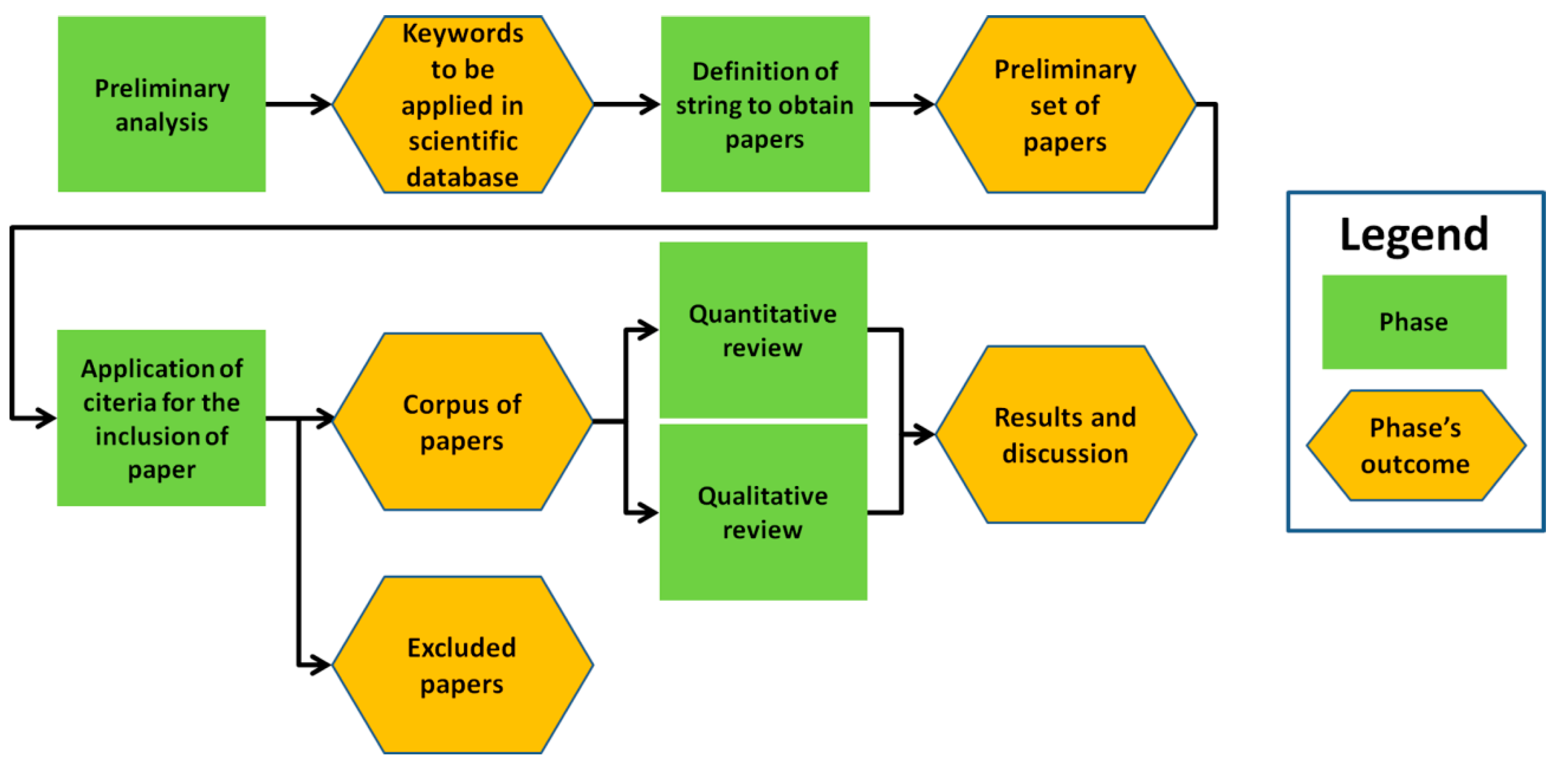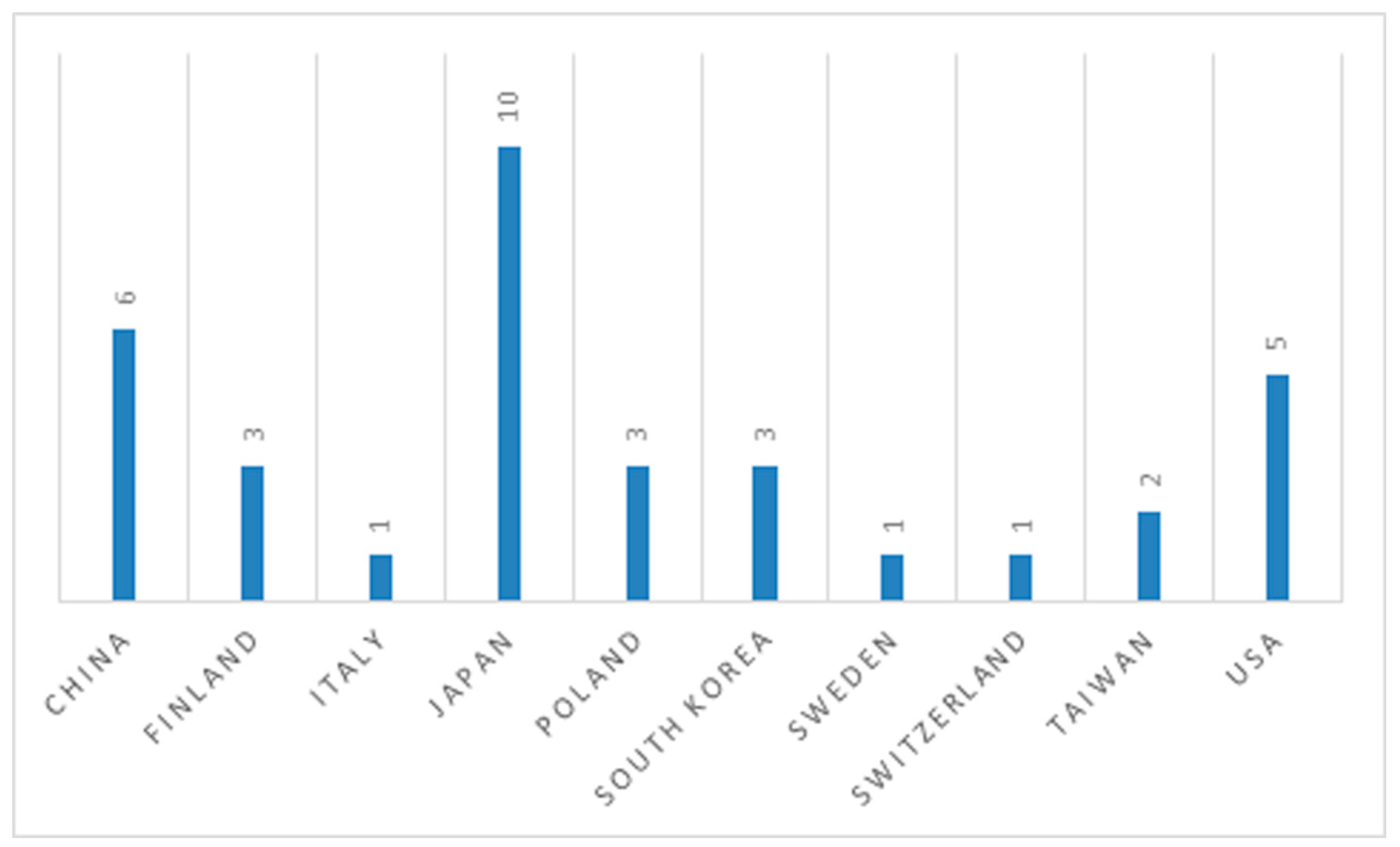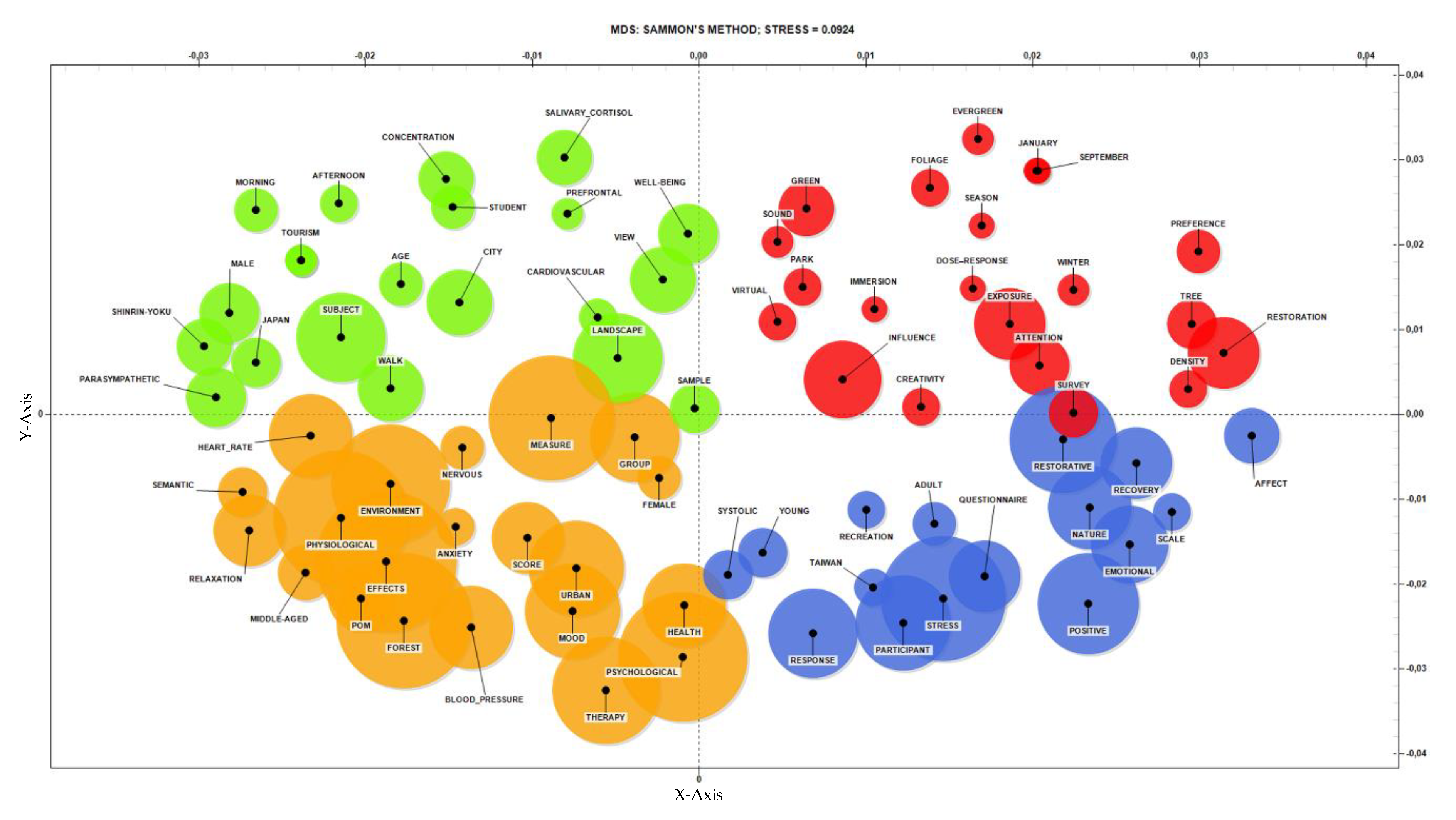Health Benefits Derived from Forest: A Review
Abstract
1. Introduction
2. Materials and Methods
2.1. Database Collection
2.2. Text Mining Analysis
3. Results and Discussion
3.1. Quantitative Review (Text Analysis)
3.2. Performance Measurement
3.3. Forests’ Effects of Relaxation and Rest
3.4. Influence of Forest Characteristics
4. Knowledge Gaps
5. Conclusions
Author Contributions
Funding
Conflicts of Interest
References
- Pukkala, T.; Kellomäki, S.; Mustonen, E. Prediction of the amenity of a tree stand. Scand. J. Res. 1988, 3, 533–544. [Google Scholar] [CrossRef]
- Edwards, D.; Jay, M.; Jensen, F.S.; Lucas, B.; Marzano, M.; Montagné, C.; Peace, A.; Weiss, G. Public preferences for structural attributes of forests: Towards a pan-European perspective. Policy Econ. 2012, 19, 12–19. [Google Scholar] [CrossRef]
- Paletto, A.; De Meo, I.; Grilli, G.; Nikodinoska, N. Effects of different thinning systems on the economic value of ecosystem services: A case-study in a black pine peri-urban forest in Central Italy. Ann. Res. 2017, 60. [Google Scholar] [CrossRef]
- Grilli, G.; Paletto, A.; De Meo, I. Economic Valuation of Forest Recreation in an Alpine Valley. Balt. For. 2014, 20, 167–175. [Google Scholar]
- Paletto, A.; De Meo, I.; Cantiani, M.G.; Maino, F. Social Perceptions and Forest Management Strategies in an Italian Alpine Community. Mt. Res. Dev. 2013, 33, 152–160. [Google Scholar] [CrossRef]
- Olson, L.E.; Squires, J.R.; Roberts, E.K.; Miller, A.D.; Ivan, J.S.; Hebblewhite, M. Modeling large-scale winter recreation terrain selection with implications for recreation management and wildlife. Appl. Geogr. 2017, 86, 66–91. [Google Scholar] [CrossRef]
- Giergiczny, M.; Czajkowski, M.; Żylicz, T.; Angelstam, P. Choice experiment assessment of public preferences for forest structural attributes. Ecol. Econ. 2015, 119, 8–23. [Google Scholar] [CrossRef]
- UN. World Urbanization Prospects: The 2014 Revision, Highlights. United Nations, Dep Econ Soc Aff (UN/DESA), Popul Div United Nations Publ. Available online: Https//Esa.Un.Org/Unpd/Wup/Publications/Files/WUP2014-Highlights.Pdf (accessed on 22 August 2020).
- Gascon, M.; Zijlema, W.; Vert, C.; White, M.P.; Nieuwenhuijsen, M.J. Outdoor blue spaces, human health and well-being: A systematic review of quantitative studies. Int. J. Hyg. Environ. Health 2017, 220, 1207–1221. [Google Scholar] [CrossRef]
- White, M.P.; Alcock, I.; Grellier, J.; Wheeler, B.W.; Hartig, T.; Warber, S.L.; Bone, A.; Depledge, M.H.; Fleming, L.E. Spending at least 120 minutes a week in nature is associated with good health and wellbeing. Sci. Rep. 2019, 9, 1–11. [Google Scholar] [CrossRef]
- Jiang, S. Therapeutic landscapes and healing gardens: A review of Chinese literature in relation to the studies in western countries. Front. Arch. Res. 2014, 3, 141–153. [Google Scholar] [CrossRef]
- Pouya, S.; Demİrel, Ö. What is a healing garden? Akdeniz Üniversitesi Ziraat Fakültesi Derg. 2015, 28, 5–10. [Google Scholar]
- Naderi, J.R.; Shin, W.-H. Humane design for hospital landscapes: A case study in landscape architecture of a healing garden for nurses. Herd Health Environ. Res. Des. J. 2008, 2, 82–119. [Google Scholar] [CrossRef] [PubMed]
- Bowler, D.E.; Buyung-ali, L.M.; Knight, T.M.; Pullin, A.S. A systematic review of evidence for the added benefits to health of exposure to natural environments. BMC Public Health 2010, 10, 456. [Google Scholar] [CrossRef] [PubMed]
- Bielinis, E.; Takayama, N.; Boiko, S.; Omelan, A.; Bielinis, L. The effect of winter forest bathing on psychological relaxation of young Polish adults. Urban For. Urban Green. 2018, 29, 276–283. [Google Scholar] [CrossRef]
- Park, B.J.; Tsunetsugu, Y.; Kasetani, T.; Kagawa, T.; Miyazaki, Y. The physiological effects of Shinrin-yoku (taking in the forest atmosphere or forest bathing): Evidence from field experiments in 24 forests across Japan. Environ. Health Prev. Med. 2010, 18–26. [Google Scholar] [CrossRef]
- Ulrich, R.; Simons, R.; Losito, B.; Fiorito, E.; Miles, M.A.; Zelson, M. Stress recovery During Expositure to Natural and Urban Environments. J. Environ. Psychol. 1991, 11, 201–230. [Google Scholar] [CrossRef]
- Beil, K.; Hanes, D. The Influence of Urban Natural and Built Environments on Physiological and Psychological Measures of Stress—A Pilot Study. Int. J. Environ. Res. Public Health 2013, 1250–1267. [Google Scholar] [CrossRef]
- Bolasco, S. Analisi Multidimensionale dei Dati: Metodi, Strategie e Criteri D’interpretazione; Carocci: Rome, Italy, 2002; ISBN 8843014013. [Google Scholar]
- Sammon, J.W. A nonlinear mapping for data structure analysis. IEEE Trans. Comput. 1969, 100, 401–409. [Google Scholar] [CrossRef]
- Hartig, T.; Evans, G.W.; Jamner, L.D.; Davis, D.S.; Tommy, G. Tracking restoration in natural and urban field settings. J. Environ. Psychol. 2003, 23, 109–123. [Google Scholar] [CrossRef]
- Hansmann, R.; Hug, S.; Seeland, K. Restoration and stress relief through physical activities in forests and parks. Urban For. Urban Green. 2007, 6, 213–225. [Google Scholar] [CrossRef]
- Park, B.J.; Tsunetsugu, Y.; Kasetani, T.; Hirano, H.; Kagawa, T.; Sato, M.; Miyazaki, Y. Physiological effects of Shinrin-yoku (taking in the atmosphere of the forest)—Using salivary cortisol and cerebral activity as indicators. J. Physiol. Anthr. 2007, 26, 123–128. [Google Scholar] [CrossRef] [PubMed]
- Park, B.; Tsunetsugu, Y.; Ishii, H.; Furuhashi, S.; Hirano, H.; Kagawa, T.; Miyazaki, Y. Physiological effects of Shinrin-yoku ( taking in the atmosphere of the forest ) in a mixed forest in Shinano Town, Japan. Scand. J. For. Res. 2008. [Google Scholar] [CrossRef]
- Li, Q.; Otsuka, T.; Kobayashi, M.; Wakayama, Y.; Inagaki, H.; Katsumata, M.; Hirata, Y.; Li, Y.; Hirata, K.; Shimizu, T.; et al. Effects of forest environments on cardiovascular and metabolic parameters. For. Med. 2012, 2016, 117–136. [Google Scholar]
- Annerstedt, M.; Jönsson, P.; Wallergård, M.; Johansson, G.; Karlson, B.; Grahn, P.; Marie, Å.; Währborg, P. Physiology & Behavior Inducing physiological stress recovery with sounds of nature in a virtual reality forest—Results from a pilot study. Psychol. Behav. 2013, 118, 240–250. [Google Scholar]
- Tsunetsugu, Y.; Lee, J.; Park, B.; Tyrväinen, L.; Kagawa, T.; Miyazaki, Y. Landscape and Urban Planning Physiological and psychological effects of viewing urban forest landscapes assessed by multiple measurements. Landsc. Urban Plan. 2013, 113, 90–93. [Google Scholar] [CrossRef]
- Jiang, B.; Chang, C.Y.; Sullivan, W.C. A dose of nature: Tree cover, stress reduction, and gender differences. Landsc. Urban Plan. 2014, 132, 26–36. [Google Scholar] [CrossRef]
- Korpela, K.; Borodulin, K.; Neuvonen, M.; Paronen, O.; Tyrväinen, L. Analyzing the mediators between nature-based outdoor recreation and emotional well-being. J. Environ. Psychol. 2014, 37, 1–7. [Google Scholar] [CrossRef]
- Tyrväinen, L.; Ojala, A.; Korpela, K.; Lanki, T.; Tsunetsugu, Y. The in fl uence of urban green environments on stress relief measures: A field experiment. J. Environ. Psychol. 2014, 38, 1–9. [Google Scholar] [CrossRef]
- Jung, W.H.; Woo, J.M.; Ryu, J.S. Effect of a forest therapy program and the forest environment on female workers’ stress. Urban For. Urban Green. 2015, 14, 274–281. [Google Scholar] [CrossRef]
- Ochiai, H.; Ikei, H.; Song, C.; Kobayashi, M.; Miura, T.; Kagawa, T.; Li, Q.; Kumeda, S.; Imai, M.; Miyazaki, Y. Physiological and psychological effects of a forest therapy program on middle-aged females. Int. J. Environ. Res. Public Health 2015, 12, 15222–15232. [Google Scholar] [CrossRef]
- Chiang, Y.-C.; Li, D.; Jane, H.-A. Wild or tended nature? The effects of landscape location and vegetation density on physiological and psychological responses. Landsc. Urban Plan. 2017, 167, 72–83. [Google Scholar] [CrossRef]
- Ohe, Y.; Ikei, H.; Song, C.; Miyazaki, Y. Evaluating the relaxation effects of emerging forest-therapy tourism: A multidisciplinary approach. Tour. Manag. 2017, 62, 322–334. [Google Scholar] [CrossRef]
- Park, S.-H.; Yeon, P.-S.; Hong, C.-W.; Yeo, E.-H.; Han, S.-M.; Lee, H.-Y.; Lee, H.-J.; Kang, J.-W.; Cho, H.-S.; Kim, Y.-H. A Study on the effect of the forest healing programs on teachers’ stress and PANAS. Korean J. Environ. Ecol. 2017, 31, 606–614. [Google Scholar] [CrossRef]
- Park, S.A.; Song, C.; Oh, Y.A.; Miyazaki, Y.; Son, K.C. Comparison of Physiological and Psychological Relaxation Using Measurements of Heart Rate Variability, Prefrontal Cortex Activity, and Subjective Indexes after Completing Tasks with and without Foliage Plants. Int. J. Environ. Res. Public Health 2017, 14, 1087. [Google Scholar] [CrossRef] [PubMed]
- Bielinis, E.; Omelan, A.; Boiko, S.; Bielinis, L. The Restorative Effect of Staying in a Broad-Leaved Forest on Healthy Young Adults in Winter and Spring. Balt. For. 2018, 24, 218–227. [Google Scholar]
- Chen, H.T.; Yu, C.P.; Lee, H.Y. The effects of forest bathing on stress recovery: Evidence from middle-aged females of Taiwan. Forests 2018, 8, 403. [Google Scholar] [CrossRef]
- Bielinis, E.; Bielinis, L.; Krupińska-Szeluga, S.; Łukowski, A.; Takayama, N. The effects of a short forest recreation program on physiological and psychological relaxation in young Polish adults. Forests 2019, 10, 34. [Google Scholar] [CrossRef]
- Lee, H.J.; Son, Y.H.; Kim, S.; Lee, D.K. Healing experiences of middle-aged women through an urban forest therapy program. Urban For. Urban Green. 2019, 38, 383–391. [Google Scholar] [CrossRef]
- Song, C.; Ikei, H.; Kagawa, T.; Miyazaki, Y. Effects of walking in a forest on young women. Int. J. Environ. Res. Public Health 2019, 16, 229. [Google Scholar] [CrossRef]
- Wang, X.; Shi, Y.; Zhang, B.; Chiang, Y. The Influence of Forest Resting Environments on Stress Using Virtual Reality. Int. J. Environ. Res. Public Health 2019, 16, 3263. [Google Scholar] [CrossRef]
- Yu, C.P.S.; Hsieh, H. Beyond restorative benefits: Evaluating the effect of forest therapy on creativity. Urban For. Urban Green. 2020, 51, 126670. [Google Scholar] [CrossRef]
- Huang, Q.; Yang, M.; Jane, H.A.; Li, S.; Bauer, N. Trees, grass, or concrete? The effects of different types of environments on stress reduction. Landsc. Urban Plan. 2020, 193, 103654. [Google Scholar] [CrossRef]
- Kim, J.G.; Khil, T.G.; Lim, Y.; Park, K.; Shin, M.; Shin, W.S. The Psychological Effects of a Campus Forest Therapy Program. Int. J. Environ. Res. Public Health 2020, 17, 3409. [Google Scholar] [CrossRef] [PubMed]
- Kuper, R. Preference and restorative potential for landscape models that depict diverse arrangements of defoliated, foliated, and evergreen plants. Urban For. Urban Green. 2020, 48, 126570. [Google Scholar] [CrossRef]
- Sacchelli, S.; Grilli, G.; Capecchi, I.; Bambi, L.; Barbierato, E.; Borghini, T. Neuroscience Application for the Analysis of Cultural Ecosystem Services Related to Stress Relief in Forest. Forests 2020, 11, 190. [Google Scholar] [CrossRef]
- Janeczko, E.; Bielinis, E.; Wójcik, R.; Woźnicka, M.; Kedziora, W.; Lukowski, A.; Elsadek, M.; Szyc, K.; Janeczko, K. When urban environment is restorative: The effect of walking in suburbs and forests on psychological and physiological relaxation of young polish adults. Forests 2020, 11, 591. [Google Scholar] [CrossRef]
- Zeng, C.; Lyu, B.; Deng, S.; Yu, Y.; Li, N.; Lin, W.; Li, D.; Chen, Q. Benefits of a three-day bamboo forest therapy session on the physiological responses of university students. Int. J. Environ. Res. Public Health 2020, 17, 3238. [Google Scholar] [CrossRef]
- Wang, Y.; Jiang, M.; Huang, Y.; Sheng, Z.; Huang, X.; Lin, W.; Chen, Q.; Li, X.; Luo, Z.; Lv, B. Physiological and psychological effects of watching videos of different durations showing urban bamboo forests with varied structures. Int. J. Environ. Res. Public Health 2020, 17, 3434. [Google Scholar] [CrossRef]
- Bielinis, E.; Simkin, J.; Puttonen, P.; Tyrväinen, L. Effect of viewing video representation of the urban environment and forest environment on mood and level of procrastination. Int. J. Environ. Res. Public Health 2020, 17, 5109. [Google Scholar] [CrossRef]
- Wang, R.; Zhao, J. Effects of evergreen trees on landscape preference and perceived restorativeness across seasons. Landsc. Res. 2020, 45, 649–661. [Google Scholar] [CrossRef]
- Wickelmaier, F. An introduction to MDS. Sound Qual. Res. UnitAalb. Univ. Den. 2003, 46, 1–26. [Google Scholar]
- Sacchelli, S.; Fabbrizzi, S.; Bernetti, I.; Menghini, S. State of the art of ecosystem services research at the global level: A multiscale quantitative review. Int. J. Environ. Sustain. Dev. 2017, 16, 359–378. [Google Scholar] [CrossRef]
- Watson, D.; Clark, L.A.; Tellegen, A. Development and Validation of Brief Measures of Positive and Negative Affect: The PANAS Scales. J. Pers. Soc. Psychol. 1988, 54, 1063–1070. [Google Scholar] [CrossRef] [PubMed]
- Hartig, T.; Lindblom, K.; Ovefelt, K. The home and near-home area offer restoration opportunities differentiated by gender. Scand. Hous. Plan. Res. 1998, 15, 283–296. [Google Scholar] [CrossRef]
- Yu, C.-P.; Lee, H.-Y.; Luo, X.-Y. The effect of virtual reality forest and urban environments on physiological and psychological responses. Urban For. Urban Green. 2018, 35, 106–114. [Google Scholar] [CrossRef]
- Lemyre, L. Psychological stress measure (PSM-9): Integration of an evidence-based approach to assessment, monitoring, and evaluation of stress in physical therapy practice. Physiother. Theory Pract. 2009, 25, 453–462. [Google Scholar] [CrossRef] [PubMed]
- Lee, I.; Choi, H.; Bang, K.S.; Kim, S.; Song, M.K.; Lee, B. Effects of forest therapy on depressive symptoms among adults: A systematic review. Int. J. Environ. Res. Public Health 2017, 14, 321. [Google Scholar] [CrossRef]
- Marušáková, L.; Sallmannshofer, M. Human Health and Sustainable Forest Management; Forest Europe: Zvolen, Slovakia, 2019. [Google Scholar]



| Nomenclature | |
|---|---|
| PANAS | Positive And Negative Affect Schedule |
| POMS | Profile Of Mood States |
| SVS | Subjective Vitality Scale |
| PSS | Perceived Stress Scale |
| RAND 36 | Emotional well-being scale |
| SDM | Semantic differential method |
| TMD | Total mood disturbance |
| STAI | State-Trait Anxiety Inventory |
| ROS | Restoration Outcome Scale |
| MBI | Maslach Burnout Inventory |
| Authors | Year | Source | Self-Rated Measures | Physiological Measures |
|---|---|---|---|---|
| Ulrich et al. | 1991 | [17] | - | blood pressure, muscle tension |
| Hartig et al. | 2003 | [21] | - | blood pressure |
| Hansmann et al. | 2007 | [22] | non-validated measures | - |
| Park et al. | 2007 | [23] | - | cortisol, electroencephalography (EEG) |
| Park et al. | 2008 | [24] | - | cortisol, heart beat |
| Park et al. | 2009 | - | cortisol, heart beat | |
| Li et al. | 2012 | [25] | POMS | blood pressure, heart beat, urine dopamine, and cardiovascular and metabolic parameters |
| Annerstedt et al. | 2013 | [26] | - | cortisol, cardiovascular data |
| Beil and Hanes | 2013 | [18] | PSS | cortisol |
| Tsunetsugu et al. | 2013 | [27] | POMS, ROS | blood pressure, heart beat, nervous activity |
| Jiang et al. | 2014 | [28] | - | cortisol, skin conductance |
| Korpela et al. | 2014 | [29] | RAND 36 | |
| Tirvainen et al. | 2014 | [30] | ROS | cortisol |
| Jung et al. | 2015 | [31] | MBI | cortisol, heartbeat, natural killer cell |
| Ochiai et al. | 2015 | [32] | SDM, POMS, TMD | blood pressure |
| Chiang et al. | 2017 | [33] | POMS | EEG |
| Ohe et al. | 2017 | [34] | POMS | blood pressure, heart beat |
| Park et al. | 2017 | [35] | PANAS | heart rate, prefrontal cortex activity |
| Song et al. | 2017 | [36] | SDM | heartbeat, blood pressure |
| Bielinis | 2018 | [37] | PANAS, POMS, ROS, SVS | |
| Chen et al. | 2018 | [38] | POMS, STAI | salivary amylase, blood pressure, heart beat |
| Bielinis et al. | 2019 | [39] | ROS, POMS | blood pressure, heartbeat |
| Lee et al. | 2019 | [40] | non-validated measures | - |
| Song et al. | 2019 | [41] | POMS, STAI | nervous activity, heartbeat |
| Wang et al. | 2019 | [42] | POMS | |
| Chia-Pin and Hsieh | 2020 | [43] | POMS, TMD | |
| Huang et al. | 2020 | [44] | - | skin conductance |
| Kim et al. | 2020 | [45] | POMS | |
| Kuper | 2020 | [46] | - | heartbeat, blood pressure |
| Sacchelli et al. | 2020 | [47] | ROS | EEG |
| Janeczko et al. | 2020 | [48] | POMS, PANAS, ROS, SVS | heart rate, blood pressure |
| Zeng et al. | 2020 | [49] | SDM | peripheral oxygen saturation, heartbeat, blood pressure |
| Jiang | 2020 | [50] | - | EEG, skin conductance, heartbeat, blood pressure |
| Bielinis et al. | 2020 | [51] | fluid procrastination | - |
| Wang and Zao | 2020 | [52] | - | EEG |
© 2020 by the authors. Licensee MDPI, Basel, Switzerland. This article is an open access article distributed under the terms and conditions of the Creative Commons Attribution (CC BY) license (http://creativecommons.org/licenses/by/4.0/).
Share and Cite
Grilli, G.; Sacchelli, S. Health Benefits Derived from Forest: A Review. Int. J. Environ. Res. Public Health 2020, 17, 6125. https://doi.org/10.3390/ijerph17176125
Grilli G, Sacchelli S. Health Benefits Derived from Forest: A Review. International Journal of Environmental Research and Public Health. 2020; 17(17):6125. https://doi.org/10.3390/ijerph17176125
Chicago/Turabian StyleGrilli, Gianluca, and Sandro Sacchelli. 2020. "Health Benefits Derived from Forest: A Review" International Journal of Environmental Research and Public Health 17, no. 17: 6125. https://doi.org/10.3390/ijerph17176125
APA StyleGrilli, G., & Sacchelli, S. (2020). Health Benefits Derived from Forest: A Review. International Journal of Environmental Research and Public Health, 17(17), 6125. https://doi.org/10.3390/ijerph17176125




